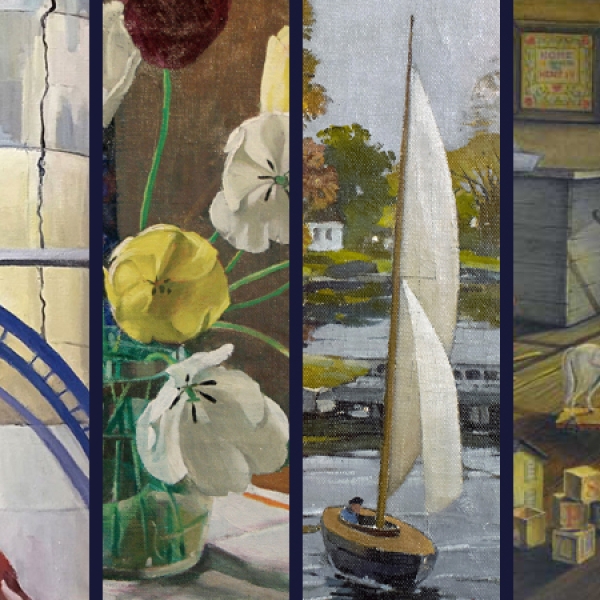

What's Not to Love? Exhibition at MMoA
What's Not to Love? Exhibition, celebrating Mystic Museum of Art's LGBTQ Founders!
At Mystic Museum of Art (MMoA), 2024 is the year of “Pathways,” exploring the routes by which artists have overcome discriminatory barriers to achieve creative success. Featuring more than 40 works of art on display from the Museum’s permanent collection and on loan from the Lyman Allyn Art Museum and private collectors, What’s Not to Love? focuses on four important members of the Mystic Art Association (MAA): Beatrice Lavis Cuming (1903–1974), Carl Emerson Lawless (1894–1964), Nathaniel Stanton Little (1893–1971), and Paul Lowell White (1917–1997).
These artists enjoyed conventional, Academic training according to the standards of their day. They all received the “right” education at prestigious schools and academies, travelled abroad to expand their horizons, and won national awards. However, as members of the LGBTQ community they faced serious danger, simply because of whom they loved.
During the 1950s, the height of many of these artists’ careers, the Connecticut Department of Mental Health classified homosexuality as a mental disorder. Police raids and purges on bars and other public spaces were commonplace. Being arrested or “exposed” put one at risk of harassment, job loss, social ruin, institutionalization and, until 1971, incarceration.
Nationally, conditions were no better. Police departments, the FBI, and the U.S. Post Office kept lists of known gay and lesbian individuals and tracked delivery of “suspicious” materials. Despite the valiant service of individuals like Carl Lawless and Nat Little, veterans of World War I, and Paul White and his partner Lee Howard, veterans of World War II, the U.S. Department of Defense believed that homosexuality was “incompatible with military service.” Senator Joseph McCarthy’s Lavender Scare following World War II targeted LGBTQ men and women just as fiercely as his Red Scare persecuted alleged Communists. Between 1947 and 1950, 1,700 federal job applications were denied, 420 federal employees were fired, and 4,380 gay and lesbian service members were purged.
Popular sentiment about the LGBTQ community began to shift in 1969, following a series of violent protests sparked by a police raid at the Stonewall Inn, a gay bar in Greenwich Village. The Stonewall Riots were not the first time LGBTQ individuals fought back against persecution, but they are considered the beginning of the modern LGBTQ rights movement. Pride Month takes place in June to coincide with their anniversary.
Connecticut did eventually pass a Gay Rights Bill in 1991, more than twenty years after it was first introduced. Of the four artists featured in this exhibition, only Paul White lived to see it. In 2008, eleven years after he passed away, Connecticut became the second state to legalize same-sex marriage.
The rights afforded to the LGBTQ community in 2024 would likely have been unfathomable to the artists in this exhibition. By necessity, most of them were not publicly “out” during their lifetimes; yet neither were they fully closeted. Unlike many others, even today, Beatrice Cuming, Nat Little, Carl Lawless, and Paul White had networks of caring family and friends who supported their artistic aspirations. How many other promising careers were cut short, or never had the opportunity to begin?
In an election year when LGBTQ rights remain a hot button issue, MMoA invites you to view the works of art on display in this exhibition and ask yourself: What’s Not to Love?











